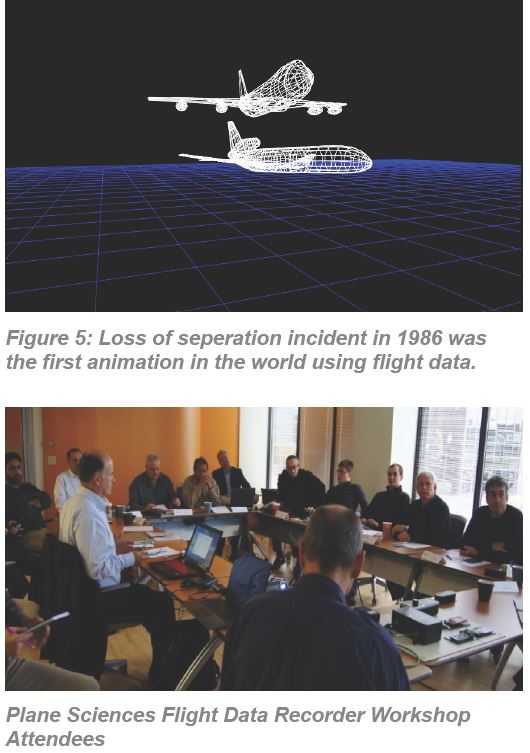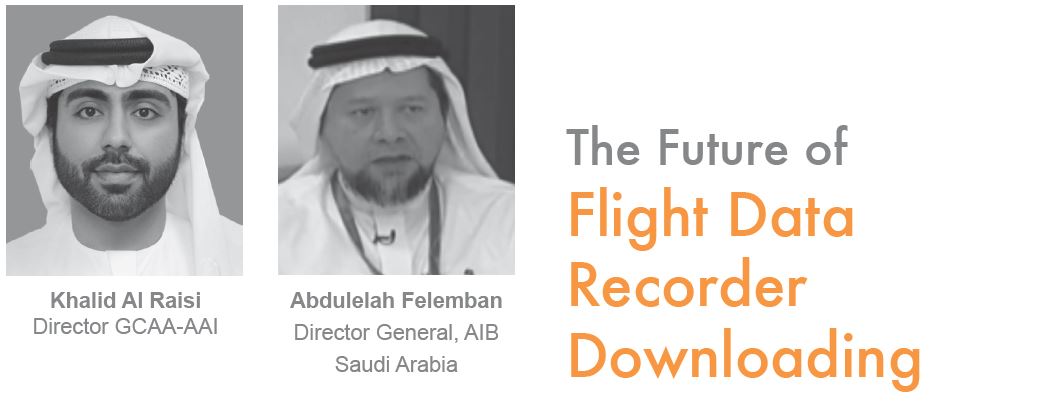
The AIB of Saudi Arabia sponsored a flight recorder workshop which was delivered by Canadian based Plane Sciences. The workshop was held in Ottawa, Canada. Plane Sciences specializes in helping investigation authorities establish and develop their technical accident investigation capabilities.
Fifteen attendees from several investigation authorities attended the four-day session at the invitation of the AIB Director General.
The AIB invitation is part of an outreach strategy that AIB have adopted to harness cooperation with all investigation authorities. The investigation authorities that participated in this workshop were the UAE GCAA, Russia MAK (IAC), French BEA, Swiss STSB, German BFU, and the Malaysian AAIB. The four-day session included a detailed training course on all aspects of flight data analysis from the very early days, through to the latest technologies used today, as well as a glimpse into the future.
The training was followed by a review of the latest flight data analysis software FAS© under development by Applied Informatics & Research (AIRINC) and Plane Sciences. A significant component of the workshop was a detailed review of the progress of the Memory Access Retreival System (MARS) under development by Plane Sciences for the AIB flight recorder laboratory.
Aviation accident investigators are often faced with retrieving flight and audio data from severely crash-damaged Flight Data Recorders (FDR) and Cockpit Voice Recorders (CVR). Impact, water and fire damage frequently render recorders unplayable requiring them to be disassembled to extract the solid state memory board contained within the Crash-Survivable-Memory-Unit (CSMU). The CSMU is designed to protect the internal memory from high impact forces, high temperature short duration and low temperature long duration fire, as well as long duration water immersion. Earlier generation digital tape recorders were the standard throughout the late 60’s through to the 90’s when solid state memory was introduced. Over the years, accident investigators have developed innovative ways well beyond the recorder manufacturers’ routine playback solution in order to extract the data from severely damaged recorders.
The principles of Plane Sciences formerly worked at the Transportation Safety Board of Canada (TSB) and were responsible for establishing the TSB’s flight recorder laboratory back in the 1980’s. During their time at TSB, they developed a universal flight recorder replay system that was capable of handling all digital tape recorders by acquiring the raw tape signal from the playback head and processing the signal with software instead of the hardware supplied by the recorder manufacturer.
The advantages of this universal software approach were significant in that the normal replay system from the manufacturer required the recorder to be functional (in most accidents it is no longer functional due to crash-damage). Digital tape recorders were also prone to missing data due to small vibrations or ‘wow and flutter’ typical during flight, and more common during flight upsets, that often predicate an accident.
The logic in the manufacturers’ hardware interface could not cope with the variations in the signal during recording and there was no ability to manually visualize the signal being processed. With the standard replay, the data was simply lost forever. For routine airline maintenance readouts, these ‘dropouts’ as they became known, were not a problem, but Murphy’s Law is such that in the case of a major accident, data tends to be missing right were you most need it and dropouts frequently hindered investigations. In fact, there have been many investigations where critical data was missing due to dropouts.
The software developed at TSB was unique in the world in that it was able to recover dropouts and in some cases, a few seconds of missing data that were able to be recovered, changed the entire outcome of the investigation. The TSB made the specialized replay technology available to collegiate authorities including the US NTSB, French BEA, Australian ATSB and the German BFU in the early 1990’s.
In 1990 when solid state was introduced, flight recorder experts expressed concerns based on their digital tape history experience that with this new technology comes a new learning curve of similar and more complex issues with solid state. As well, the rapid memory chip evolution has resulted in a proliferation of solid state flight recorder models, unlike the relatively low number of models in the tape era.
There are now over 40 solid state recorder models on the market compared to less than a dozen of the early digital tape based units. There are now 1st generation solid state recorders where the chips are no longer being manufactured and in some cases the engineer that designed and is intimate with the memory structure is no longer around.
While solid state recorders have been a huge advantage in terms of increased reliability, they represent a new risk to the accident investigation community in terms of being able to handle the inevitable cases where the replay does not work as planned.
Unlike tape recorders, they are much more complex. When investigators decided to allow solid state recorder technology, just as with tape, it was considered impractical and unreasonable to require recorder manufacturers to develop accident level replay systems.
Investigators accepted the default method to replay a crash-damaged recorder as simply removing the memory board from the accident flight recorder and substituting the memory into an actual working flight recorder (referred to as a ‘Golden Chassis’) of the same make and model.
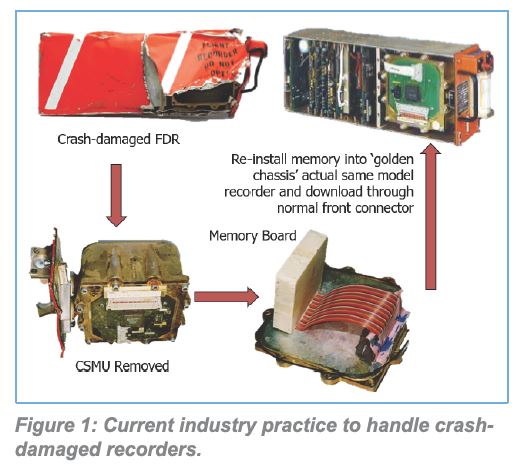
The accident memory can then be downloaded through the electronic signal processing of the recorder with a standard front panel interface connection used by the airlines for routine maintenance downloads.
The Saudi Arabian AIB engaged Plane Sciences to help them improve their capabilities to handle crash-damaged recorders. The first problem the AIB was faced with, given the current industry practice of using the golden chassis method, was that they would have to purchase over 40 actual flight recorders. Add to this that several of the earlier models are no longer being manufactured; add to this that there have already been cases where the golden chassis replay did not work, or missed data, due to things like aircraft power interruptions which are not uncommon in an accident sequence.
In these rare cases, where the standard replay did not work, the authority had to engineer a one-off method to replay the memory module/chips directly in the aftermath of the accident. Major accidents attract high media attention and there is a demand on the authority to produce information quickly for many reasons, not the least of which is that there can be urgent safety issues that need to be addressed.
Plane Sciences principals who were the original developers of the TSB universal digital tape based recorder replay system, recommended to the AIB that the time was ripe to engineer a similar universal replay system for solid state recorders. The benefits of a systemic approach across all recorder types include more visibility into the memory structure to handle data problems; less reliance on the recorder manufacturer who may or may not be in business, and may or may not have resident detailed expertise still available on the recorder type; eliminates the need to buy an inventory of bench units; and arguably most importantly, identifying shortcomings in the detailed memory structure documentation now instead of years from now only to perhaps find the documentation is inadequate.
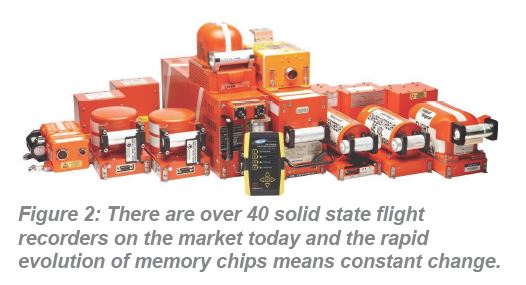
Development of MARS© (Memory Access Retrieval System) now significantly reduces the risk that investigators will find the MH370 flight recorders one day only to discover that they cannot play them back due to problems with the readout and lack of documentation/expertise deep down with the knowledge as to how the data was stored in memory. There have been early tape recorders where there was literally only one person on the planet who knew the inner workings and had he been gone; the recorder would not have been read out.
Under contract from the AIB, Plane Sciences has completed the first prototype of MARS© which enables
Figure 2: There are over 40 solid state flight recorders on the market today and the rapid evolution of memory chips means constant change.
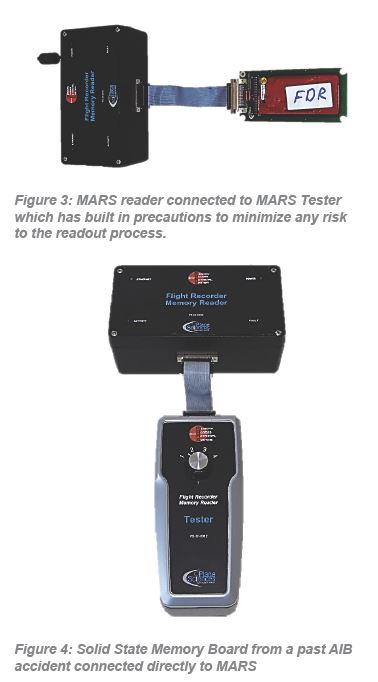
Semi-annual publication on Air Accident Investigation from UAE General Civil Aviation Authority 9
the AIB to connect the memory board from the accident recorder directly and read the memory chips one by one. MARS was designed with an extendable methodology to allow additional recorder types to be added with an appropriate adapter cable to connect to the one standard MARS connection point. Since data is critical to accident investigators every precaution must be taken to ensure that the memory cannot be damaged. To that end, AIB first uses a specially built tester to test the MARS reader, as well as employing special procedures to test that there are no shorts in the connector cable.
Unlike replaying through a Golden Chassis where the memory is processed back into what was input to the recorder, MARS takes an image of the actual memory structure and the restructuring of the data is accomplished in software. This approach has a huge advantage if bit level editing is required to recover data losses due to aircraft issues affecting the input bit stream to the recorder, a common issue in many accidents.
To date MARS can handle 5 of the 40+ recorders on the market; 5 down 35+ to go! MARS promises to provide a superior approach than the default method of simply replacing the memory into a good flight recorder and crossing your fingers that everything will work and if it doesn’t, hoping that the original designers are available and have the documentation and/or remember what they did deep down in the recorder.
It is not a good emergency response plan for the authorities to have to rely on the recorder manufacturers’ ability to support them in their hour of need and it is clearly much better to undertake research and development in advance. Hence, the need for the MARS project. The relatively small number of flight recorder specialists around the world are all too familiar with, albeit rare, data problems. Given the importance of flight data in accident investigation today, the AIB is committed to the success of the MARS project.
Once MARS has reconstructed the source data from the memory, the accident flight can be reconstructed using the latest FAS© software which also was part of the focus of the workshop. The principles at Plane Sciences were the first in the world to ‘fly’ an aircraft on a computer screen with flight data in 1986 when at the TSB. Flight animation/reconstruction is an invaluable investigative and communication tool, but like everything else, it is complex and it is easy to make mistakes and to be misled.
